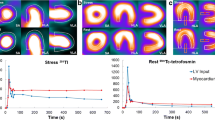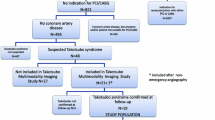Abstract
Background
The aim of this study was to evaluate the value of attenuation correction of technetium 99m tetrofosmin single photon emission computed tomography (SPECT) imaging for the detection of myocardial viability.
Methods and Results
A head-to-head comparison between resting Tc-99m tetrofosmin SPECT and fluorine 18 fluorodeoxyglucose (FDG) SPECT was performed. Both the noncorrected and attenuation-corrected Tc-99m tetrofosmin SPECT images were compared with the FDG images that served as the reference for viability. Consecutive patients (n = 33) with chronic coronary artery disease and left ventricular dysfunction were included. Segmental Tc-99m tetrofosmin and FDG data were displayed in polar maps (17-segment model), and the segments were normalized to peak activity by use of the 4D-MSPECT software program. Segments with normalized FDG activity greater than 50% were considered viable. A similar cutoff value to assess viability was used for the noncorrected and attenuation-corrected Tc-99m tetrofosmin images. Regional contractile function was determined from the gated Tc-99m tetrofosmin images and scored as normokinesia, hypokinesia, or akinesia/dyskinesia. Of all segments, 482 (85%) were viable on FDG SPECT. Of these, 427 (89%) were classified as viable with noncorrected Tc-99m tetrofosmin. Thus 55 (11%) were underestimated with noncorrected Tc-99m tetrofosmin SPECT; these segments were mainly located in the inferior and inferoseptal regions. Attenuation correction changed the classification of 39 (70%) of the underestimated segments to viable. By use of attenuation correction, the agreement between Tc-99m tetrofosmin and FDG imaging improved from 84% to 90%. Similar observations were made when the analysis was restricted to the dysfunctional segments.
Conclusion
The addition of attenuation correction to Tc-99m tetrofosmin SPECT significantly improved detection of myocardial viability in patients with chronic coronary artery disease, although minimal underestimation of viability remained as compared with FDG SPECT imaging.
Similar content being viewed by others
References
Di Carli MF, Davidson M, Little R, et al. Value of metabolic imaging with position emission tomography for evaluating prognosis in patients with coronary artery disease and left ventricular dysfunction. Am J Cardiol 1994;73:527–33.
Rahimtoola SH. The hibernating myocardium. Am Heart J 1989; 117:211–21.
Tillisch J, Brunken R, Marshall R, et al. Reversibility of cardiac wall-motion abnormalities predicted by positron tomography. N Engl J Med 1986;314:884–8.
Acampa W, Cuocolo A, Petretta M, et al. Tetrofosmin imaging in the detection of myocardial viability in patients with previous myocardial infarction: comparison with sestamibi and Tl-201 scintigraphy. J Nucl Cardiol 2002;9:33–40.
Altehoefer C, vom-Dahl J, Biedermann M, et al. Significance of defect severity in technetium-99m-MIBI SPECT at rest to assess myocardial viability: comparison with fluorine-18-FDG PET. J Nucl Med 1994;35:569–74.
Bax JJ, Cornel JH, Visser FC, et al. Prediction of recovery of myocardial dysfunction after revascularization. Comparison of fluorine-18 fluorodeoxyglucose/thallium-201 SPECT, thallium-201 stress-reinjection SPECT and dobutamine echocardiography. J Am Coll Cardiol 1996;28:558–64.
Dilsizian V, Arrighi JA, Diodati JG, et al. Myocardial viability in patients with chronic coronary artery disease. Comparison of 99mTc-sestamibi with thallium reinjection and [18F]fluorodeoxy-glucose. Circulation 1994;89:578–87.
Kapur A, Latus KA, Davies G, et al. A comparison of three radionuclide myocardial perfusion tracers in clinical practice: the ROBUST study. Eur J Nucl Med Mol Imaging 2002;29:1608–16.
Kauffman GJ, Boyne TS, Watson DD, Smith WH, Beller GA. Comparison of rest thallium-201 imaging and rest technetium-99m sestamibi imaging for assessment of myocardial viability in patients with coronary artery disease and severe left ventricular dysfunction. J Am Coll Cardiol 1996;27:1592–7.
Matsunari I, Fujino S, Taki J, et al. Myocardial viability assessment with technetium-99m-tetrofosmin and thallium-201 reinjection in coronary artery disease. J Nucl Med 1995;36:1961–7.
Baer FM, Voth E, Deutsch HJ, et al. Predictive value of low dose dobutamine transesophageal echocardiography and fluorine-18 fluorodeoxyglucose positron emission tomography for recovery of regional left ventricular function after successful revascularization. J Am Coll Cardiol 1996;28:60–9.
Kuijpers D, Ho KY, van Dijkman PR, Vliegenthart R, Oudkerk M. Dobutamine cardiovascular magnetic resonance for the detection of myocardial ischemia with the use of myocardial tagging. Circulation 2003; 107:1592–7.
Iliceto S, Galiuto L, Marchese A, et al. Analysis of microvascular integrity, contractile reserve, and myocardial viability after acute myocardial infarction by dobutamine echocardiography and myocardial contrast echocardiography. Am J Cardiol 1996;77:441–5.
Acampa W, Cuocolo A, Sullo P, et al. Direct comparison of technetium 99m-sestamibi and technetium 99m-tetrofosmin cardiac single photon emission computed tomography in patients with coronary artery disease. J Nucl Cardiol 1998;5:265–74.
Freeman I, Grunwald AM, Hoory S, Bodenheimer MM. Effect of coronary occlusion and myocardial viability on myocardial activity of technetium-99m-sestamibi. J Nucl Med 1991;32:292–8.
Burt RW, Perkins OW, Oppenheim BE, et al. Direct comparison of fluorine-18-FDG SPECT, fluorine-18-FDG PET and rest thallium-201 SPECT for detection of myocardial viability. J Nucl Med 1995;36:176–9.
Kaltoft A, Bottcher M, Sand NP, et al. 99mTc-sestamibi SPECT is a useful technique for viability detection: results of a comparison with NH3/FDG PET. Scand Cardiovasc J 2001;35:245–51.
Sawada SG, Allman KC, Muzik O, et al. Positron emission tomography detects evidence of viability in rest technetium-99m sestamibi defects. J Am Coll Cardiol 1994;23:92–8.
DePuey EG. How to detect and avoid myocardial perfusion SPECT artifacts. J Nucl Med 1994;35:699–702.
Hendel RC, Berman DS, Cullom SJ, et al. Multicenter clinical trial to evaluate the efficacy of correction for photon attenuation and scatter in SPECT myocardial perfusion imaging. Circulation 1999; 99:2742–9.
Kjaer A, Cortsen A, Rahbek B, Hasseldam H, Hesse B. Attenuation and scatter collection in myocardial SPET: improved diagnostic accuracy in patients with suspected coronary artery disease. Eur J Nucl Med Mol Imaging 2002;29:1438–42.
Miles J, Cullom SJ, Case JA. An introduction to attenuation collection. J Nucl Cardiol 1999;6:449–57.
Corbett JR, Ficaro EP. Clinical review of attenuation-corrected cardiac SPECT. J Nucl Cardiol 1999;6:54–68.
DePuey EG, Garcia EV. Optimal specificity of thallium-201 SPECT through recognition of imaging artifacts. J Nucl Med 1989;30:441–9.
Gallowitsch HJ, Sykora J, Mikosch P, et al. Attenuation-corrected thallium-201 single-photon emission tomography using a gadolinium-153 moving line source: clinical value and the impact of attenuation collection on the extent and severity of perfusion abnormalities. Eur J Nucl Med 1998;25:220–8.
O’connor MK, Kemp B, Anstett F, et al. A multicenter evaluation of commercial attenuation compensation techniques in cardiac SPECT using phantom models. J Nucl Cardiol 2002;9:361–76.
Matsunari I, Boning G, Ziegler SI, et al. Attenuation-corrected 99mTc-tetrofosmin single-photon emission computed tomography in the detection of viable myocardium: comparison with positron emission tomography using 18F-fluorodeoxyglucose. J Am Coll Cardiol 1998;32:927–35.
Wallis JW, Miller TR. Rapidly converging iterative reconstruction algorithms in single-photon emission computed tomography. J Nucl Med 1993;34:1793–800.
Cerqueira MD, Weissman NJ, Dilsizian V, et al. Standardized myocardial segmentation and nomenclature for tomographic imaging of the heart: a statement for healthcare professionals from the Cardiac Imaging Committee of the Council on Clinical Cardiology of the American Heart Association. J Nucl Cardiol 2002;9:240–5.
Ficaro EP, Kritzman JN, Corbett JR. Development and clinical validation of normal Tc-99m sestamibi database: comparison of 3D-MSPECT to Cequal [abstract]. J Nucl Med 1999;40(Suppl):125P.
Maes AF, Borgers M, Flameng W, et al. Assessment of myocardial viability in chronic coronary artery disease using technetium-99m sestamibi SPECT. Correlation with histologic and positron emission tomographic studies and functional follow-up. J Am Coll Cardiol 1997;29:62–8.
Schinkel AF, Bax JJ, Valkema R, et al. Effect of diabetes mellitus on myocardial 18F-FDG SPECT using acipimox for the assessment of myocardial viability. J Nucl Med 2003;44:877–83.
Fleiss JL. Statistical methods for rates and proportions. 2nd ed. New York: Wiley; 1981.
Platts EA, North TL, Pickett RD, Kelly JD. Mechanism of uptake of technetium-tetrofosmin. I: Uptake into isolated adult rat ventricular myocytes and subcellular localization. J Nucl Cardiol 1995;2:317–26.
Lee VS, Resnick D, Tiu SS, et al. MR imaging evaluation of myocardial viability in the setting of equivocal SPECT results with (99m)Tc sestamibi. Radiology 2004;230:191–7.
Marzullo P, Parodi O, Sambuceti G, et al. Myocardial viability: nuclear medicine versus stress echocardiography. Echocardiography 1995;12:291–302.
Bax JJ, Wijns W, Cornel JH, et al. Accuracy of currently available techniques for prediction of functional recovery after revascularization in patients with left ventricular dysfunction due to chronic coronary artery disease: comparison of pooled data. J Am Coll Cardiol 1997;30:1451–60.
Flamen P, Bossuyt A, Franken PR. Technetium-99m-tetrofosmin in dipyridamole-stress myocardial SPECT imaging: intraindividual comparison with technetium-99m-sestamibi. J Nucl Med 1995;36:2009–15.
Shaw LJ, Hendel R, Borges-Neto S, et al. Prognostic value of normal exercise and adenosine (99m)Tc-tetrofosmin SPECT imaging: results from the multicenter registry of 4,728 patients. J Nucl Med 2003;44:134–9.
Altehoefer C, Kaiser HJ, Don R, et al. Fluorine-18 deoxyglucose PET for assessment of viable myocardium in perfusion defects in 99mTc-MIBI SPET: a comparative study in patients with coronary artery disease. Eur J Nucl Med 1992; 19:334–42.
Soufer R, Dey HM, Ng CK, Zaret BL. Comparison of sestamibi single-photon emission computed tomography with positron emission tomography for estimating left ventricular myocardial viability. Am J Cardiol 1995;75:1214–9.
Banzo I, Pena FJ, Allende RH, Quirce R, Carril JM. Prospective clinical comparison of non-corrected and attenuation- and scatter-corrected myocardial perfusion SPECT in patients with suspicion of coronary artery disease. Nucl Med Commun 2003;24:995–1002.
Kluge R, Sattler B, Seese A, Knapp WH. Attenuation collection by simultaneous emission-transmission myocardial single-photon emission tomography using a technetium-99m-labelled radiotracer: impact on diagnostic accuracy. Eur J Nucl Med 1997;24:1107–14.
Slart RH, Que TH, Van Veldhuisen DJ, et al. Effect of attenuation collection on the interpretation of (99m)Tc-sestamibi myocardial perfusion scintigraphy: the impact of 1 year’s experience. Eur J Nucl Med Mol Imaging 2003;30:1505–9.
Matsunari I, Kanayama S, Yoneyama T, et al. Myocardial distribution of (18)F-FDG and (99m)Tc-sestamibi on dual-isotope simultaneous acquisition SPET compared with PET. Eur J Nucl Med Mol Imaging 2002;29:1357–64.
Author information
Authors and Affiliations
Corresponding author
Rights and permissions
About this article
Cite this article
Slart, R.H.J.A., Bax, J.J., Sluiter, W.J. et al. Added value of attenuation-corrected Tc-99m tetrofosmin SPECT for the detection of myocardial viability: Comparison with FDG SPECT. J Nucl Cardiol 11, 689–696 (2004). https://doi.org/10.1016/j.nuclcard.2004.06.131
Received:
Accepted:
Issue Date:
DOI: https://doi.org/10.1016/j.nuclcard.2004.06.131




